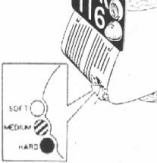





The stand was cable-operated, with this 'pull-button'!
"The stand will almost certainly claim the Power & Pedal "Oscar" for the year, as the easiest and
safest stand yet devised. A gentle pull on this button and the machine rolls back without any effort at all"
Power &
Pedal, August 1956



section through petrol cap
A great example of 'form follows function' ...these louvres front and rear create an air bridge through the body,
directing cooling air onto the head, and adding one of the Piattis greatest visual features.
Economical and functional, the split-rim wheels were interchangeable, with 4.5" expanding brakes.
If the tiny
7x3.5" tyres didn't hold when you braked, do not fear, as there was a wraparound rubber bumper up front.

In a configuration which was to be adopted by the Li series Lambretta, the Piatti had a horizontal cylinder, chain drive and internal hub gearbox in one compact unit.
There was a central pivot point either side of the crankcase.


Without doubt the most appealing part of the scooter is the bodyshape.
Minus a few internal stiffeners, the body is entirely monocoque in construction, and is very light as a result
A seam runs the length of the bike, joining the two halves, allowing the characteristic fluid body shape.
With a sleek, low-slung body, the Piatti is the only post-war scooter with an adjustable seat.
The small compartment under the seat holds a toolbox, and battery for the
parking light.